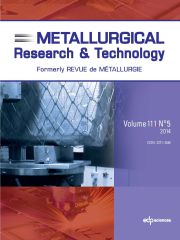Article contents
Analyzing energy and resource efficiency measures in the steeland zinc industry combining flowsheet simulation with a linear material and energy flowmodel
Published online by Cambridge University Press: 26 September 2012
Abstract
The German metal industry is confronted with an enforcing international competition,rising prices of energy and commodities, the increasing relevance of sustainable economy,political demands and incentives such as emission trading. To meet these challenges it isessential for companies to further improve resource and energy efficiency and to reduceCO2 emissions. Usually, efforts concerning these objectives focus on new orimproved single processes. In contrast, the presented approach extends the considerationsto the inter-company perspective and considers multiple processes from ferrous andnon-ferrous metals industry which are linked by material flows. Our considerations focuson residue flows in the iron and steel as well as the zinc industry. Steel production inintegrated steelworks or electric steel plants involves the formation of large amounts ofby-products, e.g. dusts, sludges or slags. These contain valuable substances such as ironor zinc and can be further processed by internal re-feeding or external recycling, e.g. byspecialized companies, particularly Waelz kiln plants or the DK process. The latterproduce zinc concentrates for the zinc industry. Changes in the modes of operation of oneor more process can therefore affect the connected processes. We investigate strategies tofurther reduce landfilling and to efficiently allocate by-products to internal andexternal recycling options within the scope of the sketched network. We develop flowsheetmodels for representative processes within the regarded industries in Germany. With anElectric Arc Furnace (EAF), an integrated steelworks, two recycling companies, and ahydrometallurgical zinc plant the major processes of the German iron, steel and zincindustries are considered. We derive linear input-output functions for each of theprocesses by means of multiple linear regression analysis which we apply on results ofsystematically varied flowsheet simulation runs. These functions are used in a system oflinear equations, forming a material and energy flow model of the regarded network. Themodel is applied to identify and assess strategies and measures to enhance resource andenergy efficiency and to reduce climate relevant CO2 emissions by scenario andsensitivity analyses. Thus, technical and economical barriers of inter-company measurescan be overcome by identifying strategies which are technologically feasible and favorablewith regard to the named objectives.
Keywords
Information
- Type
- Research Article
- Information
- Metallurgical Research & Technology , Volume 109 , Issue 5: Social Value of Materials , 2012 , pp. 359 - 367
- Copyright
- © EDP Sciences 2012
References
- 2
- Cited by

